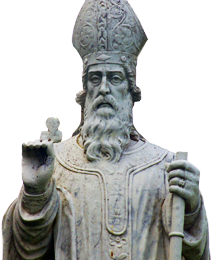|
The Dedication Ceremony for St. Patrick’s Church took place on Pentecost Sunday, 31st May 1868. On that occasion Solemn High Mass was celebrated by Bishop Nicholas Conaty. A special sermon was preached by the celebrated pulpit orator Fr. Thomas Burke, O.P. The ceremony concluded with Benediction of the Blessed Sacrament given by Bishop John Brady of Perth, Western Australia.
Drumlane Monastery was founded during the last quarter of the 6th century AD. Its founder was St. Moaodhog – Mogue or Aidan as he was known when he later became the first bishop of Ferns. The original buildings were constructed from timber, mud and wattle and were thatched with straw or reeds. No trace of these buildings has survived. In the course of subsequent centuries they were replaced with a succession of similar structures. It was not until the eleventh century that the first stone building was the Cloigtheach or Round Tower. Further stone buildings took shape during the following centuries. Drumlane Monastery was suppressed circa 1570 during the reign of Elizabeth 1st of England. The buildings at Drumlane and the Abbey lands attached to them (consisting of 8 townlands) were then declared to be Crown property. The lands eventually became part of the Annesley Estate, having earlier been granted to the O’Reillys and the Dillons. The church was assigned to the Church of Ireland vicar of Drumlane to serve as a parish church. This it did until 1821 when its congregation moved to its new place of worship at Killynaher. Nothing remains of the cloister buildings except a small section of wall. Sadly they were wantonly destroyed and used as a quarry to provide building materials for the houses of the local squires and tenant farmers.
|




